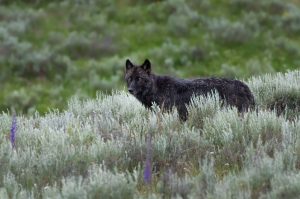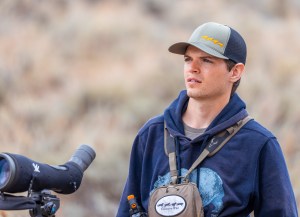A Standoff Between Predator Species: Another Great Day in Yellowstone’s Northern Range!

Photo courtesy of Yellowstone Wild Guide Evan Watts / Watts Wildlife Photography.
Sparse clouds caught the orange glow of the rising sun as we drove east. It was a cool, damp morning in mid-July, and as we made our way into the Lamar Valley, the sun rose just enough to reveal the gentle, rolling slopes that rose up around the valley floor. To our right, an enormous herd of hundreds of bison began waking for the day. It was almost rutting season, and they were gathering up en masse for this spectacle, when the bulls would viciously battle, sometimes to the death, for mating rights. It was early, but it was already shaping up to be another great day in Yellowstone’s Northern Range.
As incredible as the massive herd was to see, we continued past them without stopping. This morning, we had another target in mind: wolves. (Please see video of wolves below.)
A few miles ahead, we pulled over to scan the banks of Soda Butte Creek, where a bison had recently died of natural causes. You see, death is a bittersweet thing for those of us who watch wildlife here in Yellowstone. As heartbreaking as it is to watch an animal die, whether it’s from old age or a pack of wolves, it also gives us a unique opportunity to watch the predators that use these carcasses as a food source. A carcass like this one could bring in everything from bears, to coyotes, to ravens, to wolves, to eagles… I could go on forever. These carcasses are an important lifeline for carnivores in Yellowstone. Sometimes, the desire to feed on one leads to intense standoffs between predator species.
And—that—is exactly what happened this morning on tour in Lamar Valley.
A grizzly sow with her two cubs of the year were staked out on the carcass when we arrived. While the cubs balanced atop the bison’s ribcage, the mother bear was gorging herself. This was a critical feeding opportunity that would allow her to produce milk for her cubs. She knew she didn’t have long to feed, as there were other predators in the area, and they wanted a bite just as much as she did.
From the east, two black wolves trotted toward the carcass. The mother bear caught wind of them and stood up, surveying the scene. The first wolf stopped a few yards away from her and sized up the sow. The mother bear was clearly nervous, but she stood her ground. Two wolves were not enough of a threat to push her off of a huge carcass like this one.
Suddenly, the second wolf began to howl. Then the first wolf rejoined him and began to howl too. Then another wolf, a wolf that was out of sight from our view, started howling. Then another. And another. And another. Soon, the majority of the Junction Butte wolf pack was howling in unison, two of them just a few yards from the bears, the rest in the tree line and out of sight.
While two wolves may not have been enough to drive the sow off the carcass, an entire pack certainly was. The sow quickly gathered her cubs and meandered downstream, away from the carcass. For the following three hours we watched in awe as 11 wolves emerged from the forest and howled, rested, and fed on the carcass. The bears stayed about a half-mile away and fed on something scrumptious along the tree line.
As the sun got higher in the sky and temperatures increased, the wolves and the bears eventually disappeared into the shade of the forest. We spent the rest of the day watching mountain goats, pronghorn, bald eagles, and—of course—the bison herd from earlier this morning. Finally, with hours of great wildlife viewing and a tasty picnic lunch behind us, we made our way back to Gardiner, and that concluded another great day in Yellowstone’s Northern Range.
To see video of the standoff between the bears and wolves please click here. Photos, videos, and text are courtesy of Yellowstone Wild Guide Evan Watts / Watts Wildlife Photography.

To learn more about Evan and the rest of the Yellowstone Wild team visit our “About Us” web page.
